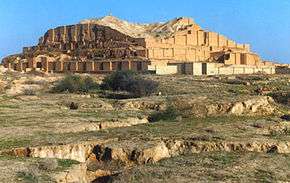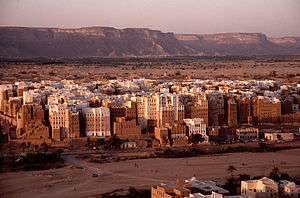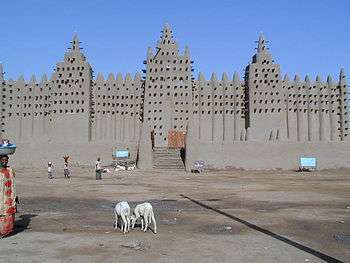Mudbrick


A mudbrick is a brick, made of a mixture of loam, mud, sand and water mixed with a binding material such as rice husks or straw.
In warm regions with very little timber available to fuel a kiln, bricks were generally sun dried. In some cases brickmakers extended the life of mud bricks by putting fired bricks on top or covering them with stucco.
Adobe
In areas of Spanish influence, mud-brick construction is called adobe, and developed over time into a complete system of wall protection, flat roofing and finishes which in modern English usage is often referred to as adobe style, regardless of the construction method.
Banco
The Great Mosque of Djenné, in central Mali, is the world's largest mudbrick structure. It, like much Sahelian architecture, is built with a mudbrick called Banco,[2] a recipe of mud and grain husks, fermented, and either formed into bricks or applied on surfaces as a plaster like paste in broad strokes. This plaster must be reapplied annually.[3]
Ancient world
The South Asian inhabitants of Mehrgarh constructed, and lived in, mud brick houses between 7000–3300 BC.[4] Mud bricks used at more than 15 reported sites in 3rd millennium BC are attributed as major cultural trait in the ancient Indus valley civilization.[5] Mudbricks were in use in the Middle East during the Pre-Pottery Neolithic B period. The Mesopotamians used sun-dried bricks in their city construction;[6] typically these bricks were flat on the bottom and curved on the top, called plano-convex mudbricks. Some bricks were formed in a square mould and rounded so that the middle was thicker than the ends. In Ancient Egypt, workers gathered mud from the Nile river, and then dug a pit and poured the mud into the pit. Workers then tramped on the mud while straw was added to solidify the mold. In Minoan Crete at the Knossos site there is archaeological evidence that sun-dried bricks were used in the Neolithic period (e.g. prior to 3400 BC).[7]
Mudbricks were used to some extent in pre-Roman Egypt, and mudbrick use increased at the time of Roman influence.[8]
Mudbrick architecture worldwide
-

Production of mudbricks for construction in Niger, 2007.
-
Mudbrick is still used today, as seen here in the Romania Danube River Delta.
-

Mudbrick high-rises in Shibam, Yemen.
-

Making mudbricks near Cooktown, Australia
See also
- Adobe – Often used in the making of mudbricks.
- Cob
- Earth structure
- Loam
- Rammed earth
Notes
- ↑ Roman Ghirshman, La ziggourat de Tchoga-Zanbil (Susiane), Comptes-rendus des séances de l'Académie des Inscriptions et Belles-Lettres, vol. 98 lien Issue 2, pp. 233-238, 1954
- ↑ SACKO, Oussouby (15 November 2015). "Issues of Cultural Conservation and Tourism Development in the Process of World Heritage Preservation" (PDF). Area Studies. Retrieved 7 October 2016.
- ↑ Bradbury, Dominic (30 October 2008). "Timbuktu: Mud, mud, glorious mud". The Telegraph. Retrieved 25 February 2012.
- ↑ Possehl, Gregory L. (1996)
- ↑ , bricks in antiquity
- ↑ Mogens Herman Hansen, A Comparative Study of Six City-state Cultures, Københavns universitet Polis centret (2002) Videnskabernes Selskab, 144 pages ISBN 87-7876-316-9
- ↑ C. Michael Hogan, Knossos fieldnotes, Modern Antiquarian (2007)
- ↑ Kathryn A. Bard and Steven Blake Shubert, Encyclopedia of the Archaeology of Ancient Egypt, 1999, Routledge, 938 pages ISBN 0-415-18589-0
References
- Possehl, Gregory L. (1996). Mehrgarh in Oxford Companion to Archaeology, edited by Brian Fagan. Oxford University Press.
External links
- Earth Architecture, website whose focus is contemporary issues in earth architecture.
- EARTHA: Earth Architecture and Conservation in East Anglia, British organisation that focuses on the proper maintenance and conservation of earth buildings in a region of the UK that has a long history of building with mud. Very experienced experts are contactable and there are regular demonstrations in the area.
- Video showing mud brick making, mud brick building and biolytic sewerage in South Africa.
- CRAterre: Centre de recherche architectural en terre, French university research organisation dedicated to unfired earth construction

